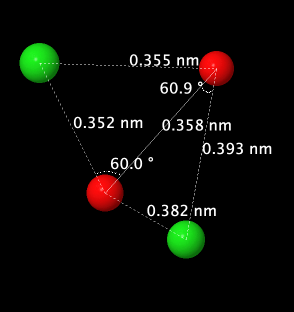|
Jmol1 will appear here.
|  |
||
| Figure 2: Interactive model of Cl2O2 with bond angles calculated from the DZV basis set using RHF SCF. Click on image to interact with the 3D model. | Figure 3: Image of the Cl2O2 geometry calculated from the ab initio DZV basis set using UHF style SCF. |
||
Bond angles at each level of theory studied are listed below in Table 2 and an interactive model of the molecule with bond lengths displayed is shown in Figure 2.
| Theory |
Cl-O-O Bond Angle |
Cl-O-O-Cl Bond Angle |
| PM3 |
110.7 ° |
107.3 ° |
| AM1 |
110.7 ° | 107.3 ° |
| 6-21G |
115.6 ° | 88.0 ° |
| 6-31G |
107.9 ° | 96.3 ° |
| DZV |
109.8 ° | 93.9 ° |
| Experimental2 |
110.07 ° | 81.03 ° |
Bond lengths and angles are were not reported for the UHF SCF type because at every level of theory and basis set, the atoms of the molecule were "blown apart" (Figure 3). For the levels of theory and basis sets that used the RHF type SCF, the semi-empirical AM1 method produced the bond lengths closest to the experimental values. However, the dihedral bond angle from the AM1 calculations was the furthest from experimental values. At the ab initio level of theory, the DZV basis set provided the bond lengths and angles closest to the reported experimental values. Since the DZV optimization provided geometries that were closest to the experimental values, these were used to determine several characteristics of the Cl2O2 molecule including the HOMO, LUMO, partial atomic charges, and the electrostatic potential.